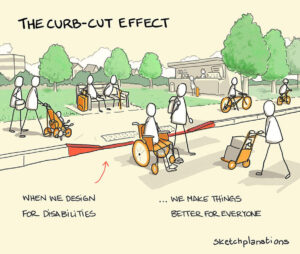The Curb-Cut Effect: Paving the Way to Inclusive Design and Universal Accessibility
In the realm of urban planning and design, the Curb-Cut Effect stands as a powerful testament to the idea that improvements made for accessibility have far-reaching benefits, positively impacting not only individuals with disabilities but society as a whole. The term “Curb-Cut Effect” originated from the installation of curb cuts, ramps that ease the transition from sidewalks to streets, designed to assist people with mobility challenges. However, its implications extend beyond physical infrastructure, emphasizing the broader advantages of creating inclusive and accessible environments for everyone.
The Origin of the Curb-Cut Effect
The story of the Curb-Cut Effect dates back to the 1970s when disability rights activists fought for the installation of curb cuts to facilitate mobility for individuals using wheelchairs. Initially, these advocates focused on creating environments that catered to the needs of people with disabilities. However, the unexpected consequence of this intervention was a transformation that benefited the entire community.
Benefits for Mothers with Baby Carriages
One prominent example of the Curb-Cut Effect is the advantage it brings to mothers with baby carriages. Ramps and curb cuts not only aid those with mobility challenges but also provide a seamless transition for strollers. This simple modification makes navigating sidewalks and streets significantly easier, enhancing the mobility and convenience of mothers and caregivers.
Assisting the Temporarily Disabled
Individuals facing temporary disabilities, such as a leg injury or recovering from surgery, also benefit from the Curb-Cut Effect. What initially aimed at aiding those with long-term mobility issues inadvertently becomes a support system for those experiencing short-term limitations, allowing them to move freely and independently during their recovery.
Convenience for Individuals Carrying Heavy Loads
Beyond physical limitations, the Curb-Cut Effect eases the daily struggles of individuals burdened with heavy bags or luggage. The smooth transition provided by accessible infrastructure proves invaluable for anyone carrying substantial loads, transforming a once challenging task into a more manageable and stress-free experience.
Examples Beyond Physical Infrastructure
The ripple effect of inclusive design extends to various aspects of daily life. Captions on movies, initially implemented to assist individuals with hearing impairments, offer a prime example. However, they have become a widely appreciated feature that enhances the viewing experience for everyone, providing clarity in noisy environments or allowing silent enjoyment during late-night viewing.
Conclusion
The Curb-Cut Effect underscores the idea that inclusivity benefits not only specific groups but society as a whole. As we design environments and products with accessibility in mind, we inadvertently create solutions that enhance the lives of individuals without disabilities. From mothers with baby carriages to those temporarily disabled or laden with bags, the Curb-Cut Effect illustrates the power of inclusive design to improve convenience, foster independence, and create a more user-friendly world for everyone.

